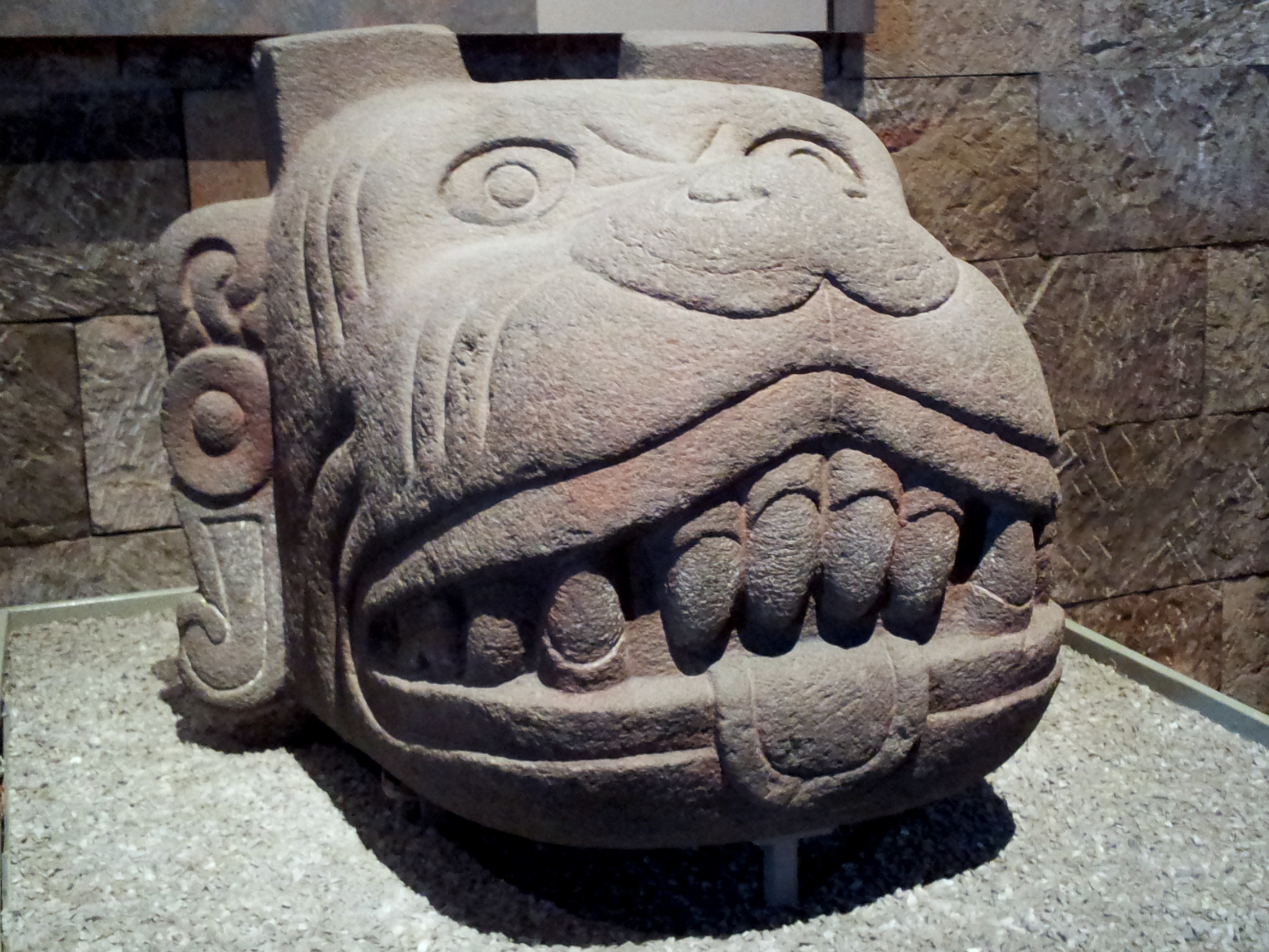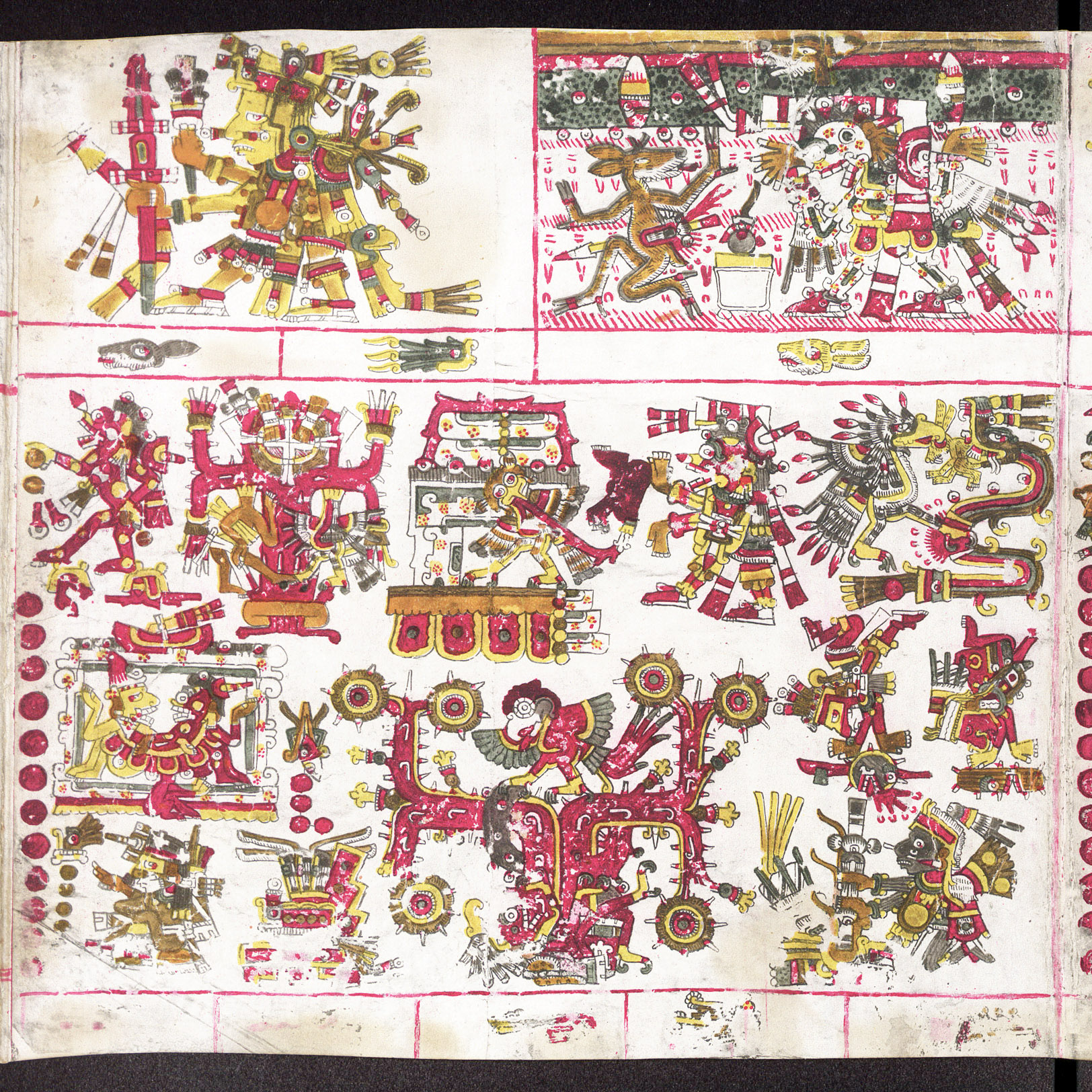|
Xolotl
In Aztec mythology, Xolotl () was a god of fire and lightning. He was commonly depicted as a dog-headed man and was a soul-guide for the dead. He was also god of twins, monsters, death, misfortune, sickness, and deformities. Xolotl is the canine brother and twin of Quetzalcoatl, the pair being sons of the virgin Chimalma. He is the dark personification of Venus, the evening star, and was associated with heavenly fire. The axolotl is named after him. Myths and functions Xolotl was the sinister god of monstrosities who wears the spirally-twisted wind jewel and the ear ornaments of Quetzalcoatl. His job was to protect the sun from the dangers of the underworld. As a double of Quetzalcoatl, he carries his conch-like ehecailacacozcatl or wind jewel. Xolotl accompanied Quetzalcoatl to Mictlan, the land of the dead, or the underworld, to retrieve the bones from those who inhabited the previous world (Nahui Atl) to create new life for the present world, Nahui Ollin, the sun of ... [...More Info...] [...Related Items...] OR: [Wikipedia] [Google] [Baidu] |
Aztec Mythology
Aztec mythology is the body or collection of myths of the Aztec civilization of Central Mexico. The Aztecs were a culture living in central Mexico and much of their mythology is similar to that of other Mesoamerican cultures. According to legend, the various groups who became the Aztecs arrived from the North into the Valley of Mexico, Anahuac valley around Lake Texcoco. The location of this valley and lake of destination is clear – it is the heart of modern Mexico City – but little can be known with certainty about the origin of the Aztec. There are different accounts of their origin. In the myth, the ancestors of the Mexica/Aztec were one of seven groups that came from a place in the north called Aztlan, to make the journey southward, hence their name "Azteca." Other accounts cite their origin in Chicomoztoc, "the place of the seven caves", or at Tamoanchan (the legendary origin of all civilizations). The Mexica/Aztec were said to be guided by their war-god Huitzil ... [...More Info...] [...Related Items...] OR: [Wikipedia] [Google] [Baidu] |
Axolotl
The axolotl (; from ) (''Ambystoma mexicanum'') is a neoteny, paedomorphic salamander, one that Sexual maturity, matures without undergoing metamorphosis into the terrestrial adult form; adults remain Aquatic animal, fully aquatic with obvious external gills. This trait is somewhat unusual among amphibians, though this trait is not unique to axolotls, and this is apparent as they may be confused with the Tadpole, larval stage or Ambystoma#Species, other neotenic adult mole salamanders (''Ambystoma spp.''), such as the occasionally paedomorphic tiger salamander (''Ambystoma tigrinum, A. tigrinum'') widespread in North America; or with mudpuppies (''Necturus spp.''), which bear a superficial resemblance but are from a different Family (biology), family of salamanders. Axolotls originally inhabited a system of interconnected wetlands and lakes in the Mexican highlands; they were known to inhabit the smaller lakes of Lake Xochimilco, Xochimilco and Lake Chalco, Chalco, and are al ... [...More Info...] [...Related Items...] OR: [Wikipedia] [Google] [Baidu] |
Codex Borgia
The Codex Borgia ( The Vatican, Bibl. Vat., Borg.mess.1), also known as ''Codex Borgianus'', ''Manuscrit de Veletri'' and ''Codex Yohualli Ehecatl'', is a pre-Columbian Middle American pictorial manuscript from Central Mexico featuring calendrical and ritual content, dating from the 16th century. It is named after the 18th century Italian cardinal, Stefano Borgia, who owned it before it was acquired by the Vatican Library after the cardinal's death in 1804. The Codex Borgia is a member of, and gives its name to, the Borgia Group of manuscripts. It is considered to be among the most important sources for the study of Central Mexican gods, ritual, divination, calendar, religion and iconography. It is one of only a handful of pre-Columbian Mexican codices that were not destroyed during the conquest in the 16th century; it was perhaps written near Cholula, Tlaxcala, Huejotzingo or the Mixtec region of Puebla. Its ethnic affiliation is unclear, and could either have been produced ... [...More Info...] [...Related Items...] OR: [Wikipedia] [Google] [Baidu] |
Xoloitzcuintle
The Xoloitzcuintle (or Xoloitzquintle, Xoloitzcuintli, or Xolo) is one of several breeds of hairless dog. It is found in standard, intermediate, and miniature sizes. The Xolo also comes in a coated variety, totally covered in fur. Coated and hairless can be born in the same litter as a result of the same combination of genes. The hairless variant is known as the Perro pelón mexicano or Mexican hairless dog. It is characterized by its wrinkles and dental abnormalities. In Nahuatl, from which its name originates, it is ''xōlōitzcuintli'' (singular) and ''xōlōitzcuintin'' (plural).''Nahuatl Dictionary.'' (1997). Wired Humanities Project. University of Oregon. Retrieved September 1, 2012, frolink The name comes from the god '' Xolotl'' that, according to ancient narratives, is its creator and ''itzcuīntli'' , meaning ' dog' in the Nahuatl language. History Ceramic sculptures of a hairless breed of dog have been found in burial sites in ancient West Mexico. In ancient t ... [...More Info...] [...Related Items...] OR: [Wikipedia] [Google] [Baidu] |
Fifth Sun
In creation myths, the term "Five Suns" refers to the belief of certain Nahua cultures and Aztec peoples that the world has gone through five distinct cycles of creation and destruction, with the current era being the fifth. It is primarily derived from a combination of myths, cosmologies, and eschatological beliefs that were originally held by pre-Columbian peoples in the Mesoamerican region, including central Mexico, and it is part of a larger mythology of Fifth World or Fifth Sun beliefs. The late Postclassic Aztecs created and developed their own version of the "Five Suns" myth, which incorporated and transformed elements from previous Mesoamerican creation myths, while also introducing new ideas that were specific to their culture. In the Aztec and other Nahua creation myths, it was believed that the universe had gone through four iterations before the current one, and each of these prior worlds had been destroyed by Gods due to the behavior of its inhabitants. The cur ... [...More Info...] [...Related Items...] OR: [Wikipedia] [Google] [Baidu] |
Mixcoatl
Mixcoatl (, from mixtli "cloud" and cōātl "serpent"), or Camaxtle or Camaxtli, was the god of the hunt and identified with the Milky Way, the stars, and the heavens in several Mesoamerican cultures. He was the patron deity of the Otomi people, Otomi, the Chichimecs, and several groups that claimed descent from the Chichimecs. Under the name of Camaxtli, Mixcoatl was worshipped as the central deity of Huejotzingo and Tlaxcala (Nahua state), Tlaxcala. Representation Mixcoatl is represented as dark skinned and with distinctive red and white pin stripes painted on his body. These features are shared with Tlahuizcalpantecuhtli, the Lord of the Dawn, god of the morning star, as well as Itzpapalotl, goddess of infant mortality who was sometimes said to be his mother. Unlike Tlahuizcalpanteuctli, Mixcoatl can usually be distinguished by his hunting gear, which included a bow and arrows, and a net or basket for carrying dead game. Mythology Mixcoatl was one of four children of Tonaca ... [...More Info...] [...Related Items...] OR: [Wikipedia] [Google] [Baidu] |
Trecena
A trecena (From Spanish: trece) is a 13-day period used in pre-Columbian Mesoamerican calendars. The 260-day Mayan calendar (the '' tonalpohualli'') was divided into 20 trecenas. Trecena is derived from the Spanish chroniclers and translates to "a group of thirteen" in the same way that a dozen (or in Spanish ''docena'') relates to the number twelve. It is associated with the Aztecs, but is called different names in the calendars of the Maya, Zapotec, Mixtec, and others of the region. Many surviving Mesoamerican codices, such as Codex Borbonicus, are divinatory calendars, based on the 260-day year, with each page representing one trecena. See also * Aztec calendar * Maya calendar The Maya calendar is a system of calendars used in Pre-Columbian era, pre-Columbian Mesoamerica and in many modern communities in the Guatemalan highlands, Veracruz, Oaxaca and Chiapas, Mexico. The essentials of the Maya calendar are based upon ... * Tonalpohualli * K'atun References Mes ... [...More Info...] [...Related Items...] OR: [Wikipedia] [Google] [Baidu] |
Mesoamerica
Mesoamerica is a historical region and cultural area that begins in the southern part of North America and extends to the Pacific coast of Central America, thus comprising the lands of central and southern Mexico, all of Belize, Guatemala, El Salvador, and parts of Honduras, Nicaragua and northwestern part of Costa Rica. As a cultural area, Mesoamerica is defined by a mosaic of cultural traits developed and shared by its indigenous cultures. In the pre-Columbian era, many Indigenous peoples of the Americas, indigenous societies flourished in Mesoamerica for more than 3,000 years before the Spanish colonization of the Americas began on Hispaniola in 1493. In world history, Mesoamerica was the site of two historical transformations: (i) primary urban generation, and (ii) the formation of New World cultures from the mixtures of the indigenous Mesoamerican peoples with the European, African, and Asian peoples who were introduced by the Spanish colonization of the Americas. Mesoameri ... [...More Info...] [...Related Items...] OR: [Wikipedia] [Google] [Baidu] |
Psychopomp
Psychopomps (from the Greek word , , literally meaning the 'guide of souls') are creatures, spirits, angels, demons, or deities in many religions whose responsibility is to escort newly deceased souls from Earth to the afterlife. Their role is not to judge the deceased, but simply to guide them. Appearing frequently on funerary art, psychopomps have been depicted at different times and in different cultures as anthropomorphic entities, horses, deer, dogs, whip-poor-wills, ravens, crows, vultures, owls, sparrows, and cuckoos. In the case of birds, these are often seen in huge masses, waiting outside the home of the dying. Overview Ancient religion Classical examples of a psychopomp are the ancient Egyptian god Anubis, the deity Pushan in Hinduism, the Greek ferryman Charon, the goddess Hecate, and god Hermes,RADULOVI, IFIGENIJA; VUKADINOVI, SNEŽANA; SMIRNOVBRKI, ALEKSANDRA – Hermes the Transformer Ágora. Estudos Clássicos em debate, núm. 17, 2015, pp. 45–62 Univers ... [...More Info...] [...Related Items...] OR: [Wikipedia] [Google] [Baidu] |
Mictlān
Mictlan () is the underworld of Aztec mythology. Most people who die would travel to Mictlan, although other possibilities exist (see " Other destinations", below). Mictlan consists of nine distinct levels. The journey from the first level to the ninth is difficult and takes four years, but the dead are aided by the psychopomp, Xolotl. The dead must pass many challenges, such as crossing a mountain range where the mountains crash into each other, a field with wind that blows flesh-scraping knives, and a river of blood with fearsome jaguars. Mictlan also features in the Aztec creation myth. Mictlantecuhtli set a pit to trap Quetzalcoatl. When Quetzalcoatl entered Mictlan seeking bones with which to create humans, Mictlantecuhtli was waiting. He asked Quetzalcoatl to travel around Mictlan four times blowing a conch shell with no holes. Quetzalcoatl eventually put some bees in the conch shell to make sound. Fooled, Mictlantecuhtli showed Quetzalcoatl to the bones. But Quetzalcoa ... [...More Info...] [...Related Items...] OR: [Wikipedia] [Google] [Baidu] |
Aztec
The Aztecs ( ) were a Mesoamerican civilization that flourished in central Mexico in the Post-Classic stage, post-classic period from 1300 to 1521. The Aztec people included different Indigenous peoples of Mexico, ethnic groups of central Mexico, particularly those groups who spoke the Nahuatl, Nahuatl language and who dominated large parts of Mesoamerica from the 14th to the 16th centuries. Aztec culture was organized into city-states (''altepetl''), some of which joined to form alliances, political confederations, or empires. The Aztec Empire was a confederation of three city-states established in 1427: Tenochtitlan, the capital city of the Mexica or Tenochca, Tetzcoco (altepetl), Tetzcoco, and Tlacopan, previously part of the Tepanec empire, whose dominant power was Azcapotzalco (altepetl), Azcapotzalco. Although the term Aztecs is often narrowly restricted to the Mexica of Tenochtitlan, it is also broadly used to refer to Nahuas, Nahua polities or peoples of central Pre ... [...More Info...] [...Related Items...] OR: [Wikipedia] [Google] [Baidu] |





